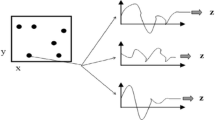Abstract
This paper shows how the entropy concept can be used inside the GIS to evaluate information content present in spatially distributed data structures. More specifically, referring to both raster and vector data structures, some experiences are shown which have been obtained on an experimental basin about the use of the entropy concept in the identification of the most suitable data set (characterized by means of the smallest data volume) to describe the rainfall-runoff process.
Access this chapter
Tax calculation will be finalised at checkout
Purchases are for personal use only
Preview
Unable to display preview. Download preview PDF.
Similar content being viewed by others
References
Shannon, C.E. and Weaver, W. (1949) The Mathematical Theory of Communication, University of Illinois Press, Urbana, Illinois.
Jaynes, E.T. (1957) Information theory and statistical mechanics I, Phys. Rev. 106, 620–630.
Jaynes, E.T. (1957) Information theory and statistical mechanics II, Phys. Rev. 108, 171–190.
Harmancioglu, N.B., Alpaslan, N. and Singh, V.P. (1992) Application of the entropy concept in design of water quality monitoring networks, in V.P. Singh and M. Fiorentino (eds.), Entropy and Energy Dissipation in Water Resources, Kluwer Academic Publishers, Dordrecht, pp. 283–302.
Copertino, V.A., de Bemardinis, B., Molino, B., Telesca, V. and Singh, V.P. (1996) An Integrated approach to observe the evolution of pollutants in reservoirs, in V.P. Singh and B. Kumar (eds.), Water Quality Hydrology, Kluwer Academic Publishers, Dordrecht, pp. 43–55.
Singh, V.P. and Fiorentino, M. (1992) A historical perspective of entropy applications in water resources, in V.P. Singh and M. Fiorentino (eds.), Entropy and Energy Dissipation in Water Resources, Kluwer Academic Publishers, Dordrecht, pp. 21–61.
Harmancioglu, N.B., Singh, V.P. and Alpaslan, N. (1992) Versatile uses of the entropy concept in water resources, in V.P. Singh and M. Fiorentino (eds.), Entropy and Energy Dissipation in Water Resources, Kluwer Academic Publishers, Dordrecht, pp. 91–117.
Vieux, B.E. (1993) DEM Aggregation and smoothing effects on surface runoff modeling, Journal of Computing in Civil Engineering 7(3), 310–338.
Colosimo, C. and Mendicino, G. (1995) Valutazione degli effetti prodotti dall’aggregazione dei dati in un modello di trasformazione afflussi-deflussi, Idrotecnica 4, 223–236.
Mendicino, G. and Sole, A. (in press) The information content theory for the estimate of topographic index distribution used in TOPMODEL.
Colosimo, C. and Mendicino, G. (1996) Scale definition in an integrated GIS hydrological model: a case study, Application of Geographic Information Systems in Hydrology and Water Resources Management — HydroGIS ‘96, Vienna, Austria, IAHS No. 235, pp. 385–393.
Colosimo, C. and Mendicino, G. (1996) Channel network source definition using entropy concept, XI International Conference on Computational Methods in Water Resources, Cancùn, Mexico.
Colosimo, C. and Mendicino, G. (1996) Indagini preliminari sul legame esistente tra il contenuto di informazione della rete di drenaggio e la risposta idrologica di un bacino idrografico, XXV Convegno di Idraulica e Costruzioni Idrauliche, Torino, Italy.
Fiorentino, M. and Claps, P. (1992) On what can be explained by the entropy of a channel network, in V.P. Singh and M. Fiorentino (eds.), Entropy and Energy Dissipation in Water Resources, Kluwer Academic Publishers, Dordrecht, pp. 139–154.
Beven, K.J. and Kirkby, M.J. (1979) A physically based variable contributing area model of basin hydrology, Hydrol Sci. Bull. 24(1), 43–69.
Beven, K., Lamb, R., Quinn, P., Romanowicz, R. and Freer, J. (1995) TOPMODEL, in V.P. Singh (ed.), Computer Models of Watershed Hydrology, Water Resources Publications, pp. 627–668.
Colosimo, C. and Mendicino, G. (1995) GIS for distributed rainfall-runoff modeling, in V.P. Singh and M. Fiorentino (eds.), GIS in Hydrology, Kluwer Academic Publishers, Dordrecht, pp. 207–247.
Singh, V.P. (1992) Elementary Hydrology, Chapter 16, Prentice Hall, Englewood Cliffs.
Maidment, D.R. (1993) Developing a spatially distributed unit hydrograph by using GIS, Application of Geographic Information Systems in Hydrology and Water Resources Management — HydroGIS ‘93, Vienna, Austria, IAHS No. 211, pp. 181–192.
Author information
Authors and Affiliations
Editor information
Editors and Affiliations
Rights and permissions
Copyright information
© 1997 Springer Science+Business Media Dordrecht
About this chapter
Cite this chapter
Mendicino, G. (1997). Analysis of the Information Content of Environmental Data Using GIS Procedures. In: Harmancioglu, N.B., Alpaslan, M.N., Ozkul, S.D., Singh, V.P. (eds) Integrated Approach to Environmental Data Management Systems. NATO ASI Series, vol 31. Springer, Dordrecht. https://doi.org/10.1007/978-94-011-5616-5_32
Download citation
DOI: https://doi.org/10.1007/978-94-011-5616-5_32
Publisher Name: Springer, Dordrecht
Print ISBN: 978-94-010-6367-8
Online ISBN: 978-94-011-5616-5
eBook Packages: Springer Book Archive




